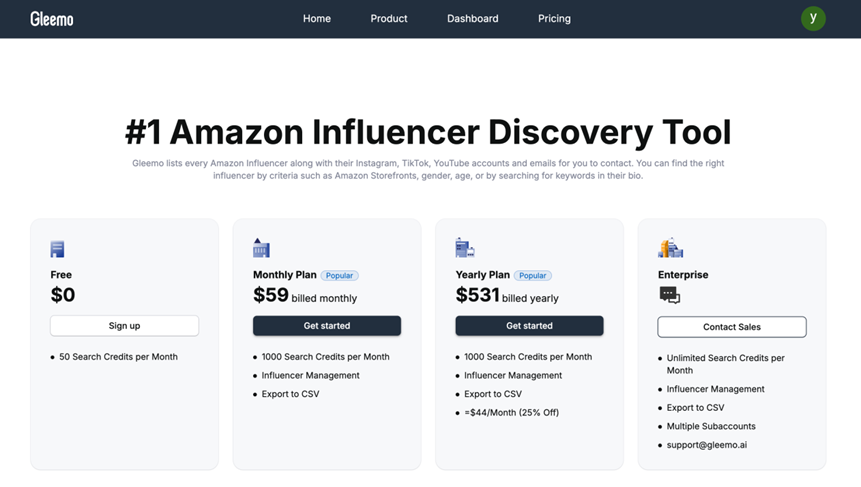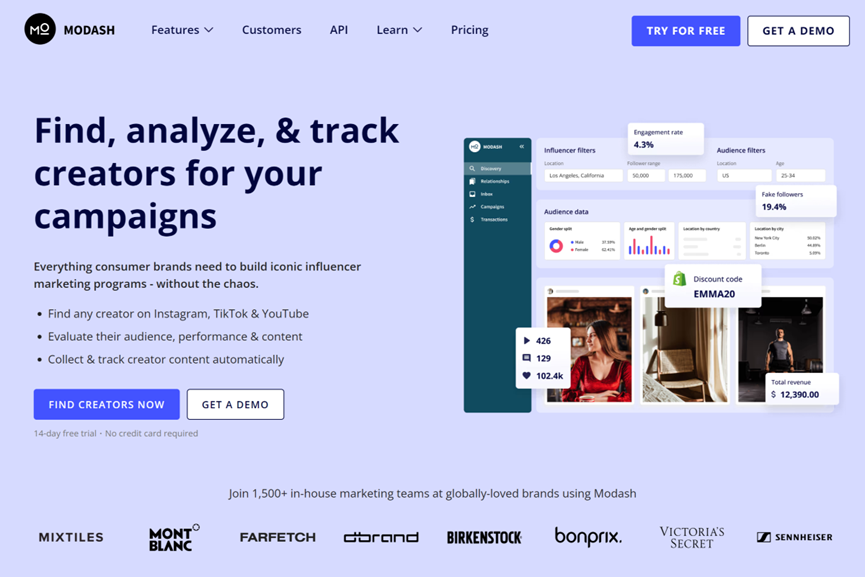3 Best Tools to Find Micro Influencers for Higher ROI
In today’s digital landscape, influencer marketing has become one of the most effective ways for brands to reach their target audience. While the buzz around top-tier influencers and celebrities is high, micro influencers—those with between 1,000 and 100,000 followers—have proven to deliver higher engagement rates and a more authentic connection with audiences. The challenge, however, lies in finding the right micro influencers who resonate with your brand values and goals.
In this guide, we’ll explore how to leverage influencer search tools to streamline your search for the ideal micro-influencers, while maximizing your ROI and forging meaningful influencer partnerships.
Best 3 Online Tools to Find Micro Influencers
As AI technology continues to advance, it presents a significant opportunity for brands to enhance their influencer marketing strategies. Here are the top three online marketing tools that can help you find micro-influencers with precision:
1. Gleemo
Gleemo is a powerful influencer marketing tool designed to simplify the influencer discovery process. It helps brands find micro influencers that align with their target audience and campaign goals by providing detailed insights into their audience demographics and engagement metrics.

Before starting your search, make sure to do thorough research to define the best content direction for your brand or product. Once you’ve identified the type of influencers you’re targeting, you can visit Gleemo’s homepage.

Gleemo offers different subscription plans, and you can also start with a free trial using a personal account.
Simply use the filter options to refine your search and click “Find Influencer” to explore the available options. For example, if you want to collaborate with fitness influencers, you can filter the results as shown in the image below and quickly generate a list of suitable influencers.

Pros :
Data-Driven Approach: Gleemo provides in-depth influencer analytics, making it easier for you to select influencers whose audience and content align with your brand.
User-Friendly Interface: The platform’s interface is intuitive and easy to navigate, which makes it ideal for users at any level of experience.
Comprehensive Filters: Gleemo provides multiple filters to narrow down your search, helping you find influencers who meet your specific criteria.
Cons:
Speed Issues: Sometimes the website may experience slow loading times due to network issues.
Influencer Range: Gleemo focuses more on influencers from platforms like Amazon, which means its database may be less comprehensive for influencers from other social media channels. However, there are still plenty of influencers available on other platforms like Instagram and TikTok.
Pricing:
Gleemo offers an affordable pricing structure with various plans. You get 50 free searches as part of the trial. Their basic plan is ideal for small and medium-sized brands and is worth considering.

2. Modash
Modash is a leading influencer marketing platform that focuses on influencer discovery, analytics, campaign tracking, inbox, management, and payments. These are the six key features of Modash.

Pros&Cons: Modash excels in influencer marketing and recently secured $12 million in Series A funding. However, it’s not suitable for individual use, and its pricing is on the higher end. Also, Modash’s filters don’t differentiate between social media platforms, which could make it harder to target the right influencers.
3.Upfluence
Upfluence is an all-in-one influencer marketing platform that provides influencer search, campaign management, and performance tracking. It offers detailed insights into influencers’ audiences, helping brands identify the right influencers based on various factors.

Pros&Cons: Upfluence offers custom services and has its own influencer marketing team, which is a major advantage for brands looking for a full-service approach. However, some users have reported that they are pushed into signing long-term contracts (usually one year), which could be a drawback for brands that prefer flexibility.
Tips for Maximizing Efficiency with Influencer Finder Tools
While AI tools can be incredibly powerful, their effectiveness depends on how well they are used. Here are the steps you should follow:
Define Your Campaign Objectives: Before you begin your search, clearly define your marketing goals. Are you looking for brand awareness, higher engagement, or direct sales? Knowing your objective will guide your influencer search.
Use Advanced Filters: Gleemo offers a variety of filters to help you narrow down your influencer search. Filter by audience demographics, niche, location, and engagement levels to find influencers that align with your brand values.
Check Engagement and Authenticity: Look for micro influencers with a high engagement rate. Remember, engagement rates are often a more valuable indicator than follower count.
Analyze Content Quality: Look at the type of content the influencer creates and assess its alignment with your brand’s values. You want to work with influencers whose content resonates with your target audience.
-
Monitor Campaign Results: Use Gleemo’s reporting and tracking tools to evaluate the success of your campaign. Regular monitoring will help you fine-tune your strategies and ensure you’re getting the best ROI.

What’s a Micro Influencer and Why Choose Them for Marketing?
We've talked a lot about micro-influencers, but you might still be wondering: what exactly are micro-influencers, and why should you consider them for your marketing strategy? Let's break it down.
A micro influencer typically has between 1,000 and 100,000 followers. Despite having a smaller following compared to micro influencers or celebrities, micro influencers tend to have a more engaged and loyal audience, which makes them ideal for niche marketing. So, if you’re looking for creative ways to market a niche product, micro-influencers could be your best bet.

Why Choose Micro Influencers?
1. Higher Engagement Rates: Micro-influencers often boast higher engagement rates than larger influencers, meaning their followers are more likely to interact with their content. This makes them valuable for brands looking to build trust and loyalty.
2. Cost-Effective: Working with micro influencers is typically less expensive than hiring larger influencers or celebrities.
According to Influencer Marketing Hub, the average cost of working with a micro-influencer on Instagram ranges from $100 to $500 per post, compared to $10,000+ for a single post with a macro-influencer. For small and medium-sized brands, micro-influencers are a much more budget-friendly choice.

3. Niche Audiences: Micro influencers usually focus on specific niches, whether it’s beauty, fitness, food, or lifestyle. This makes them perfect for brands looking to target a specific market or community.
4. Authenticity: Micro influencers often have a more personal and authentic relationship with their followers. Their content tends to feel less commercial and more organic, which increases trust and effectiveness.
Case Study:
Finnish candy brand Halva worked with 99 local micro-influencers to reach over 380,000 people. The campaign cost just €1,014 and resulted in 6,852 new followers, meaning they spent only €0.15 per new follower. This is an amazing ROI!

How to Get Higher ROI in Influencer Marketing?
Maximizing ROI in influencer marketing doesn’t just depend on selecting the right influencers; it requires a strategic, data-driven approach. Here’s how to ensure your efforts yield the highest return:
1. Set Clear Campaign Objectives
Start by setting clear, measurable objectives for your influencer marketing campaign. Whether it’s driving website traffic, generating sales, or increasing brand awareness, knowing your goals helps you select the right influencers and evaluate campaign performance effectively.
2. Target the Right Influencers
Use platforms like Gleemo to identify influencers whose audience demographics align with your target market. Choosing the right influencers is the foundation of any successful campaign, so be strategic about selecting influencers who can truly influence your audience.
3. Focus on Engagement, Not Just Follower Count
When assessing influencers, prioritize engagement rates over follower count. Micro influencers with high engagement rates often drive more meaningful interactions and conversions, which leads to a better ROI than simply reaching a larger but less engaged audience.
4. Create Authentic Content
Collaborate with your influencers to create high-quality, authentic content that resonates with their audience. The more organic and relevant the content feels, the more likely it is to convert.
5. Monitor Campaign Performance
Using tools like Gleemo’s analytics, track key performance indicators (KPIs) such as engagement rates, website clicks, conversions, and sales. Monitoring performance will allow you to assess what’s working and make adjustments in real time.
6. Optimize Your Strategy Based on Data
Regularly analyze the data from your campaigns and use it to adjust your strategy. A/B testing, for example, allows you to test different types of content, messaging, and influencer partnerships to see what generates the best results.
7. Build Long-Term Relationships
Invest in building long-term partnerships with your top-performing micro influencers. Long-term collaborations tend to generate more authentic content and deeper connections with their audience, resulting in better ROI over time.
8. Leverage Multiple Channels
Instead of focusing on one platform, consider using multiple platforms for your campaigns. Micro influencers often have followings on several social media platforms, so expanding your reach can result in higher brand visibility and more conversions.

Conclusion
Finding and working with the right micro influencers is a critical part of any successful influencer marketing campaign. Influencer management platforms offer valuable AI-driven insights and advanced filtering options that help brands find influencers who align with their marketing goals. However, it’s important to also consider other tools like Modash and Upfluence to ensure that you are selecting the best fit for your campaign.
By using the right tools, setting clear goals, and prioritizing engagement over follower count, you can maximize your ROI and create impactful, long-lasting relationships with micro influencers. Keep monitoring your campaigns,